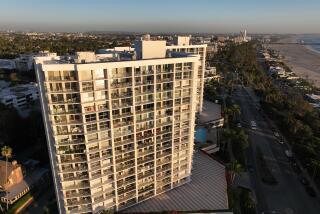Phonehenge West owner has nine strikes against him — so far
The builder of an unusual home expansion in the Antelope Valley called Phonehenge West was found guilty Tuesday of violating building codes, and a judge’s order to tear down the structure is expected.
Alan Kimble Fahey was charged with 14 misdemeanor counts, including maintenance of non-permitted properties and unlawful use of land. Jurors in Los Angeles County Superior Court in Lancaster reached a partial verdict, covering nine of the counts; they were expected to continue deliberating the remaining counts Wednesday in the courtroom of Judge Daviann L. Mitchell.
Each charge carries a possible maximum six-month jail sentence and financial penalties, according to Fahey’s attorney, Jerry Lennon.
“He faces pretty hefty fines and fees,” Lennon said. “It’s up to the judge whether she will impose any jail time.... The logical conclusion will be that she orders him to dismantle and remove the buildings that are not permitted.”
Fahey, 59, of Acton, said he was not surprised by the initial verdict. “It’s what I expected,” he said. “But I can appeal.”
A retired phone service technician, Fahey spent almost three decades constructing the 20,000-square-foot labyrinth of interconnected buildings, stopping only when Los Angeles County code enforcement officials forced him to in 2008. The creation, which includes a 70-foot tower, is a hodgepodge of reddish buildings — some built of telephone poles — connected by bridges and ramps.
During the four-day trial, deputy Dist. Atty. Patrick David Campbell told jurors that Fahey’s maze of structures did not meet building codes and must be torn down. Most of the 13 buildings violate setback requirements, and the property is in a region of high earthquake risk and lacks water and proper access for fire trucks, he said. Phonehenge is a fire hazard, he said, because so much of it was built with wood.
The prosecutor said Fahey failed to get the required building permits because he had a cavalier attitude toward code enforcement laws and willfully flouted them.
Lennon, Fahey’s attorney, countered that the jury should acquit his client “because there is no crime here.”
He argued that Fahey failed to get permits because the procedure was overly convoluted, making it “virtually impossible for an individual … to get a permit.” Fahey was caught in “a maze of regulatory bureaucracy,” Lennon said.
“He couldn’t obtain a permit because they stopped him every step of the way,” Lennon added.
On Tuesday, Fahey said he felt he never had a chance to properly defend himself during the trial. He lamented that no expert witnesses were called in his defense; he was barred from showing the jury an intricate miniature model of his structure; and the jury wasn’t permitted to tour his property and assess it first-hand.
“They stymied and stopped me on everything,” he said.
The case triggered an outpouring of support from those who share Fahey’s defiance of code enforcement.
Since The Times reported the case last month, the number of followers on a Facebook page called Save Phonehenge West ballooned from 300 to nearly 28,000. Media requests to interview Fahey have rolled in from across the globe, including Australian TV.
More to Read
Start your day right
Sign up for Essential California for news, features and recommendations from the L.A. Times and beyond in your inbox six days a week.
You may occasionally receive promotional content from the Los Angeles Times.







